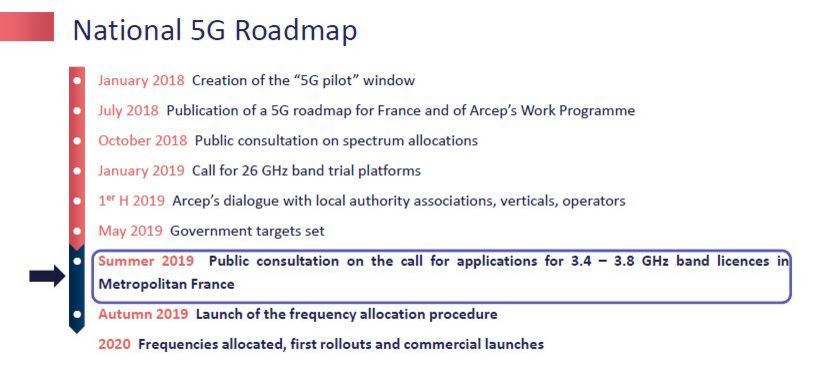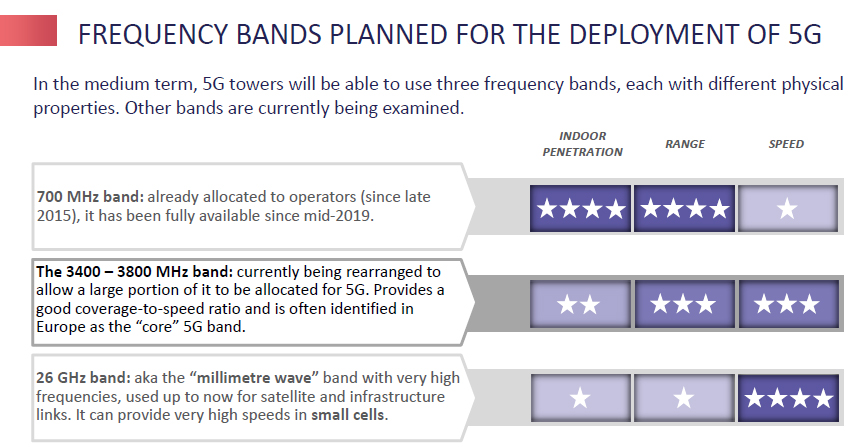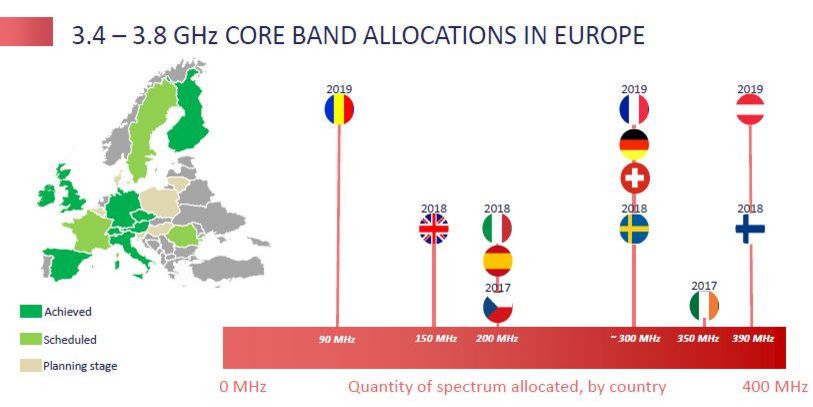Today Arcep is launching a public consultation on its draft procedure for awarding licences to use frequencies in the 3.4 – 3.8 GHz band, in Metropolitan France.
The text is part of the directions set out by the Government in a letter from Agnès Pannier-Runacher, France’s Secretary of State to the Minister for Economy and Finance, dated 2 May 2019. The contributions to this public consultation, which will run until 4 September, will enable Arcep to finalise this procedure and the terms of allocation. Arcep will then submit its final text to the Government in the following weeks, with a view to allocating frequencies in the autumn.
The press kit attached to this press release contains a summary of the main allocation parameters, notably the rate of 5G adoption across the country and in the economy’s “vertical” industries.
Press Kit
Procedure and conditions for allocating frequencies in the "core" 5G band (3.4 - 3.8 GHz): publication of a draft decision for public consultation
Today, 15 July 2019, Arcep is launching a public consultation on a draft decision that sets out the procedure and conditions for awarding licences to use frequencies in the 3.4 – 3.8 GHz band, in Metropolitan France. The contributions to this public consultation, which will run until 4 September, will enable Arcep to finalise this procedure and the terms of allocation. Arcep will then submit its final text to the Government in the weeks that follow.
1. The 3.4 – 3.8 GHz band: the “core” 5G band in Europe
In 2016 the European Commission launched an action plan that was designed to set a common timetable across Europe for the coordinated commercial launch of 5G in 2020. In 2017, the European Union’s Estonian President proposed a 5G roadmap, which was co-signed by each Member State’s minister for electronic communications. The roadmap’s targets include 5G coverage of at least one major city in each Member State in 2020, and of all the main urban areas and transport corridors by 2025. In France, the Government, in concert with Arcep, presented the national roadmap for 5G on 16 July 2018. Arcep unveiled its 5G battle plan at the same time. Below is a list of the most recent stages in that work programme:
Several bands were identified in a coordinated fashion in Europe for future 5G rollouts. The Arcep draft decision being presented today concerns 3.4 – 3.8 GHz band frequency allocations – identified in Europe as the “core” 5G band. Thanks to a combination of its physical properties and the amount of spectrum available, this band provides a good trade-off between coverage and speed. Use of this core band will be completed by other bands of varying properties, each of which will help unleash the full potential of 5G. These include the 700 MHz band, which was already allocated to operators in France in 2015, and the 26 GHz band which will be allocated at a later date.
Work is still underway in Europe on setting all of the technical conditions for the 26 GHz band. Without waiting for that to be complete, in January 2019 Arcep and the Government issued a call for the creation of 5G trial platforms. Their aim was to galvanise stakeholders around the possibilities opened up by this frequency band, and to identify new uses it will enable. Some 15 very interesting applications were received. The results of this call for applications will be revealed in September 2019.
The European Electronic Communications Code, which was adopted in late 2018, stipulates a coordinated timetable so that the core frequency bands are allocated in every Member State by the end of 2020. Other European countries have thus performed these allocations, in varying quantities. France is preparing to allocate a significant amount of spectrum: in excess of 300 MHz (see the diagram below).
2. Allocation objectives
In the letter it sent to Arcep in May 2019, the Government detailed the objectives for the regulator to pursue when drafting its specifications for 3.4 – 3.8 GHz band allocations:
- regional development: in addition to offloading mobile networks in the most densely populated parts of the country, the development of 5G services must benefit every region;
- competition: the procedure must allow at least four operators to be capable of providing 5G services under good conditions, while also having the ability to distinguish themselves from the competition;
- innovation and services for “verticals”: no frequency will be reserved for “verticals”, per se, but one objective is to provide them with services that take their particular needs into consideration, regardless of their location;
- revenue: the procedure will include a financial criterion, with a reserve price set by the Government.
The planned allocation procedure and obligations contained in the draft decision being published today for public consultation satisfy the objectives set by the government.
3. Planned allocation procedure
In the draft document being submitted for public consultation, the allocation procedure is for 310 MHz of frequencies, covering Metropolitan France. The rearrangement of the band’s current users will be decided before the procedure begins. This will help determine the winners, the amount of spectrum awarded to each and their precise position on the band. All of the winners will be subject to obligations (see Part 4).
Arcep is proposing a two-part allocation procedure that is not based solely on financial bids. The procedure will include a first part whereby up to four operators will be able to obtain additional blocks of spectrum in exchange for additional commitments, before the auctions carried out in the second part allow them to obtain additional frequencies.
3.1 First part: Optional commitments in exchange for blocks of frequency
Arcep is giving applicants the option of making a series of commitments when submitting their application. If they do make these commitments, they will be written into the obligations attached the frequency licences that are awarded to the winning candidates, and come to supplement the minimum obligations that will apply to all of the winners. The commitments and obligations are described in Part 4.
If four or fewer candidates agree to make these commitments when filing their application, each will be able to obtain a block of spectrum at a set price. If their number is equal to or over five, the applicants will bid for the four blocks in a separate auction. The size of the block, which is the subject of one of the questions in the consultation, will be at least equal to 40 MHz.
3.2 Second part: Auction allowing each operator to acquire additional frequencies
Next, an auction will be held to allocate the frequencies that are still available after the commitment phase. The qualified applicants, regardless of whether or not they obtain a block in the previous phase, will thus have the possibility of acquiring additional frequencies, divided by 10 MHz block. The initial price set for the first block of 10 MHz is determined by the reserve price set by the government, after which Arcep will conduct this multi-round auction as follows.
During each round, Arcep indicates the price of one 10 MHz block. Each applicant then indicates the number of blocks they want at that price. As long as the number of blocks requested by the operators is greater than the number of available blocks, Arcep will hold a new round and increase the unit price of each 10 MHz block, by previously established increments. The auction ends when operators’ demand matches the number of blocks available. All of the 10 MHz blocks will then be allocated at the final price bid. In a situation where the number of available blocks exceeds operators’ demand, a mechanism is in place for deciding between the last applicants to have withdrawn from the bidding.
Once the amount of spectrum allocated to each winner is known, there are multiple combinations for positioning them on the band. A new (single-round, second highest bid) auction will be held to determine each of the winners’ positions. They will thus have an opportunity to express their preferences on position on the band, and their position with respect to the other winners.
LESSONS LEARNED FROM OTHER ALLOCATIONS
Arcep has already held auctions for allocating new frequencies, notably in the 800 MHz and 2.6 GHz bands (sealed bid auction in 2011) and in the 700 MHz band (multi-round auction in 2015). The mechanism being proposed today takes a combined approach: the procedure will begin with a commitment stage that allows applicants to obtain a first quantity of spectrum, before the multi-round auction is held, which provides applicants with a clear view of the amount of spectrum they can obtain, at each round.
Arcep’s teams have spoken extensively with their European counterparts, particularly those in Germany, Italy and the UK, about the lessons learned from their own auction procedures, and to compare the mechanisms used.
For instance, to control the risk of having an overly-long bidding procedure, the planned mechanism includes the ability to substantially increase the incremental unit price of a 10 MHz block between two rounds, periodically. To give an example: after a certain number of rounds during which the price per block increases by 5 million euros with each round, Arcep could decide to raise the increase to 8 million euros for each new round.
3.3 Capping the amount of spectrum available per applicant
In the public consultation, Arcep plans to set a cap on the total amount of spectrum any one applicant can obtain (during phases 1 and 2), which is compatible with the Government’s competition objective:
- the planned minimum is a topic addressed in public consultation. It will be at least equal to 40 MHz;
- the planned maximum is 100 MHz.
4. Planned obligations and commitments
4.1 Obligations for all operators
The draft procedure being presented today stipulates that all applicants, regardless of whether or not they have chosen to make optional commitments, will be subject to a series of obligations, particularly with respect to regional coverage. These are on top of existing obligations, notably those created under the New Deal for Mobile.
a) 5G rollouts in the 3.4-3.8 GHz band that prioritise urban areas and economic zones
Arcep proposes to require that each operator launch 5G services in at least two cities (i.e. some 10 in total) before the end of 2020, and to then impose a demanding trajectory to support the deployment of 3.4 – 3.8 GHz band equipment during the following years:
- 3,000 sites in 2022,
- 8,000 sites in 2024,
- 12,000 sites in 2025.
Eventually, all of the cell sites must be providing a 5G service, using either the core band or other bands. In particular, this includes all of the new 4G cell sites that operators are currently deploying, as part of the New Deal for Mobile.
Arcep is also planning to introduce a concomitance mechanism to ensure that non-urban areas will also benefit from these rollouts. As a result, a significant percentage (around 20% to 25%) of 3.4-3.8 GHz band sites must be located in sparsely populated areas, targeting economic activity, notably manufacturing. The public consultation includes questions on how to define these areas and site proportions.
b) Increasingly ubiquitous 5G punctuated by steadily increasing speeds
To set the pace for this rollout, Arcep plans on keeping pace with growing bandwidth needs. By 2022, at least 75% of cell sites must be 5G capable, a figure that will rise steadily to 100% by 2030. The level of service is defined by a speed of at least 240 Mbit/s at each cell site. To achieve these speeds, operators can either use the new frequencies that have been allocated, or other frequencies (notably mid and low-band ones that enable better propagation). The obligations are thus designed to ensure that every part of the country will be benefit from mobile networks’ improved performances.
The intermediate targets give operators flexibility in whether to use 4G or 5G technology, provided they meet the speed requirement. By 2030, however, they must be providing 5G services on all of their sites.
By way of comparison, the obligations associated with frequencies allocated previously for 4G, stipulated speeds of 60 Mbit/s at each cell site.
c) Roadways
Obligations that apply specifically to transport corridors are also planned, with two main targets: coverage of the country’s motorways (16,642 km) by 2025 then, by 2027, coverage of the main roadways (54,913 km). These obligations stipulate connection speeds of a minimum 100 Mbit/s at each cell site.
These obligations are to be added to the road and railway line coverage obligations contained in the New Deal for Mobile, and those attached to the 700 MHz band.
d) Slicing
The new level of performance provided by 5G opens the way for innovative uses in a number of vertical industries, such as manufacturing (high-precision production, logistical tracking of a very large number of objects, proliferation of sensors), health (real time remote operations), automotive (ultra-reliable low latency communications for vehicles) and media (360° virtual reality in 3D). These verticals are expecting customised networks and products, that meet their specific needs. To make this happen, Arcep is asking operators to activate the most innovative 5G functions – i.e. slicing, or the ability to deliver tiered services – by 2023 at the latest.
e) IPv6
Furthermore, to accelerate the transition to the IPv6 routing protocol, Arcep has planned for an obligation to make mobile networks IPv6-compatible.
WHAT OBLIGATIONS HAVE BEEN ATTACHED TO ALLOCATIONS IN EUROPE?
Recent frequency allocations in this band in the UK and Spain, do to include any rollout obligations. In Italy, obligations were confined to a few locations. In Germany, obligations pertain to providing a connection of 100 Mbits/s and the target installation of 1,000 5G cell sites by 2022.
4.2 Optional commitments
A set of commitments is being proposed for candidates taking part in the first part of the allocation procedure. These commitments will then become legally binding obligations in the terms of the winning candidates’ licences.
a) 5G to foster competitiveness in other sectors of the French economy
To lay the groundwork for enterprises’ future connectivity, Arcep is proposing an unprecedented mechanism that would have operators commit to granting reasonable requests from vertical industry companies, by providing them with customised solutions in terms of coverage and performance or, if the operator prefers, by assigning its frequencies locally to verticals.
b) Indoor coverage
Arcep has also provided for commitments that seek to improve indoor coverage for business and commercial purposes, and to facilitate coverage by multiple operators.
c) Fixed access products
Commitments also concern the supply of dedicated fixed access products on mobile networks.
d) Transparency
The commitments include increasing operators’ transparency, both on their rollout forecasts and service outages.
e) Innovation and competition
Lastly, commitments are proposed to improve MVNO hosting on operators’ networks, in particular to stimulate innovation from all the sector’s players.
5. Licence duration and rendez-vous clause in 2023
The frequencies will be allocated for a period of 15 years. The procedure also provides for a possible 5-year extension.
In addition, two interim reviews are scheduled for 2023 and before 2028 to verify operators’ implementation of their obligations, along with market requirements, notably in the areas of mobile network coverage and quality of service. Obligations could be revised based on the findings of these reviews, after having reached an agreement with the licence-holder.
6. Public consultation
The public consultation being launched today will run until 4 September. All of the stakeholders wanting to contribute are invited to view the document on the Arcep website, and to follow the instructions for submitting their contributions.



